BERDICHEV'S JEWISH CEMETERY
A Crumbling Memorial to a Once Magnificent Jewish Community
[Copyright: Yael Shamir-Driver June 2001]
At the end of May, after a long period of debate and hesitation, my father, my husband and myself made it from London to Berdichev. We spent two days and two nights in Berdichev where we divided our time between locating and visiting old Jewish sites and exploring the only old surviving Jewish cemetery in the town. Below is a short description of the cemetery and the thoughts it provoked.
1. The Current State
Period: Of the three old Jewish cemeteries of Berdichev, only the one housing the gravesite of Rabbi Levy Yitzchak of Berdichev [LIOB 1740-1809] has survived. The other two cemeteries have been transformed into Shavshchenko Park. The LIOB cemetery appears to house graves which date from the middle of the eighteenth century to the late 1990s.
Location: The cemetery, which is public property, is located in the northern part of the town, on the eastern side of a main road [Lenin Street] leading out of Berdichev to Zhitomir. The entrance to the cemetery is from Lenin Street, immediately after passing over a level crossing.
Size: We believe the cemetery is approximately 250 metres wide and 550 metres long. These measurements are based on an examination of an eight-year-old official town map. We further believe that there may be around 10,000 graves in the cemetery. This estimate is based on the overall area of the cemetery and the fact that some parts of this area may have few or no graves. [Please note that US Commission Report No. UA05020101, indicates up to 5,000 stones].
State: The cemetery is overgrown and resembles a wild wood rather than a cemetery - a very depressing sight [Photo-1]
 |
Photo-1: : The cemetery and wild woodland
|
The “centrepiece” of the cemetery is the grave of LIOB, which is housed in a locked building of brick/concrete. This building is located approximately in the middle of the cemetery. Unlike the general “wild wood” state of the cemetery, the immediate area approaching LIOB burial place [on the left] has been cleared of both trees and undergrowth. In addition, a strip of approximately 30 metres by 100 metres [leading from the LIOB’s building towards Lenin Street] has been largely cleared of trees and larger shrubs. However, lower shrubs and wild weeds are still in abundance here. [Photo-2]
 |
Photo - 2: LIOB Mausoleum and stones cleared for cleaning
|
Stone Types: The gravestones in the cemetery are of various shapes and materials. The very old ones are usually made of oblong stone designed to stand upright. The writing on these stones is carved rather deeply. The stones dating from the mid 1880s are generally low long semi cylindrical shape stones [40 cm off the ground] also with fairly deep carving. The third type of stones - dating from 1900 onwards, appears to be of a granite type material where the carving is very narrow [almost a scratch] and not very deep. This makes such stones difficult to read. Many of these relatively recent stones have a special “boot like” shape, which appears to be a “local speciality”.
Condition of Stones: Many of the very old stones and the “sausage” type stones are covered with moss. However, when the moss is removed, it is often possible to read the writing [Photo-3]. Note that in many cases, surnames are not mentioned [family names become a regular feature only towards the end of the nineteenth century]. The “boot” type stones are generally clear of moss but difficult to read.
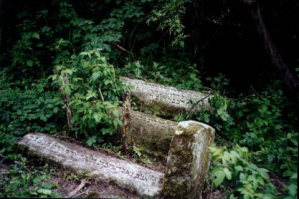 |
Photo - 3: "Sausage" type stones after initial cleaning
|
Work Done: We cleaned [with hired help] and then read about 70 stones, about half of which were situated close to the grave of LIOB [Photo-4, 5]. The majority of these stones relate to persons who died during the second half of the nineteenth century, although the earliest stone that we read dates back to 1803. On a number of stones there is reference to the deceased rabbinical ancestors [Besht, LIOB, Ish-Horowitz, Rabbi Zeev of Zitomir etc.].
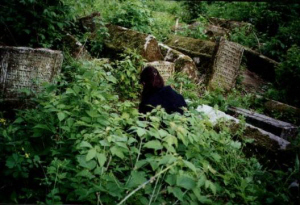 |
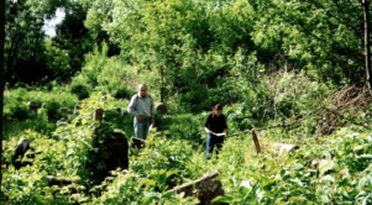 |
Reading stones in LIOB's cemetery
|
Reading stones in LIOB's cemetery
|
2. The Rescue Plan
Given the importance of Berdichev [the “Jerusalem of Vohlin”] and its central place in the development of Hassidic philosophy and given that this cemetery is still in a condition which could allow meaningful restoration, a project is being nursed with the following objectives:
Clear the cemetery of all the shrubbery and undergrowth which hides many of the stones.
Read, record and publish details of all the stones that can be read.
Reconstruct/reassemble to the extent possible stones which have been broken and/or overturned.
Establish permanent care to ensure that the restored cemetery remains in an acceptable condition.
With this in mind, and with some funds already pledged, we would be grateful to hear from anybody who can give help, advice and feedback regarding the following:
- Photographic/digital enhancement technology for the efficient reading of details on gravestones, which are difficult to read with the naked eye.
- Environmentally friendly plant control agrochemicals for use as means of eradicating shrubs and other wild growth without negative effect on the environment.
- Fundraising – names of potential donor both organisations and individuals that would pledge the remaining financial support required for the project.
- Volunteers – people prepared to spend time in Berdichev to work ‘on the ground’. We are particularly looking for people experienced in reading traditional Hebrew inscriptions on gravestones.
SECOND VISIT IN SEPTEMBER 2001 TO THIS CEMETERY
A Progress Report and a Thought for Yom Kippur
[copyright Yael Shamir-Driver September 2001]
Following my initial writeup on the cemetery of Berdichev), I am very pleased to follow up with a report about the work that has taken place since June, including some photographic evidence of the results.
Following the securing of initial funds, the Rabbi of Berdichev has worked to obtain a permit from the municipality to clear the cemetery area of overgrowth and certain trees. Having received this permit, a local contractor was asked to clear a small area in order to ascertain that his work was of the required standard and that he would work carefully without causing any damage to the gravestones. The contractor’s work proved to be satisfactory and on this basis he was awarded a contract to clear a larger plot.
After some eight weeks of work we have the first photos showing the results of this work. Large amounts of undergrowth have been cleared away and gravestones, which were barely visible at the time of our June visit, are now clear and ready for ‘reading’. Of course, many of the stones are not completely upright but generally the picture is one of great improvement and what one would hope to see when visiting a cemetery such as the one in Berdichev.
Although the photographs reveal a completely “new cemetery”, the area currently cleaned is probably no more than one sixth of the total area of the cemetery. Moreover, unless treated with an appropriate herbicide, the growth will probably reappear. We are currently investigating the most appropriate form of treatment and any professional ideas would be welcomed.
The current clearing work will continue for another month until winter starts to set in. Next spring we would like to complete the clearance of the undergrowth in the rest of the cemetery, effect the chemical treatment and carry out the most important aspect of the project, which is to read and record the details of as many gravestones as possible. The latest set of photographs [see a sample below] encourages us that many of the stones may still be legible.
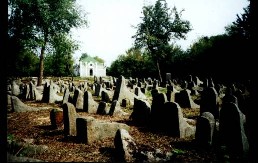 |
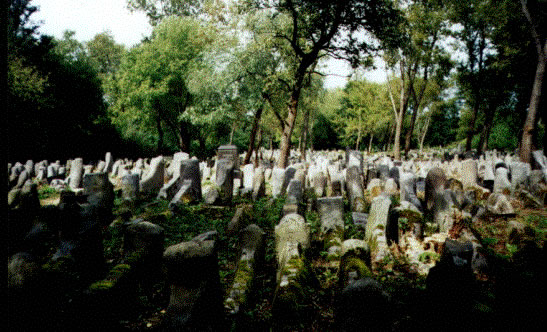 |
Berdichev Cemetery – 1st stage of the clean up |
All this means that we will need to secure more support and in particular we will be looking for volunteers to help the documentation process planned for next year.
So here is a call, to all you Berdichevers and descendants thereof – please consider if you can help.
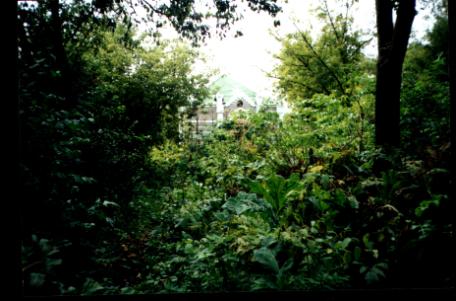 |
Berdichev cemetery – before the start of the clean up
|
BERDICHEV JEWISH CEMETERY RESTORATION - UKRAINE
Report of the U.S. Commission for the Preservation of America's Heritage Abroad
about this cemetery.
The Commission has begun an ambitious multi-year project to restore the historic Jewish cemetery in Berdichev, Ukraine. The cemetery is one of the most important in Ukraine, in part due to the artistic quality of its gravestones. Approximately 5,000 stones are still on the site, some dating from as early as the 18th century.
Beginning in the 18th century, Berdichev was a center of the Hasidic movement, which transformed Jewish religious practice in much of Eastern Europe. Many of Hasidism’s revered leaders are buried here. Among the most famous is Rabbi Levi Isaac, who died in 1809.
The Jewish population of Berdichev peaked at nearly 50,000 in the mid-19th century. It declined to 14,000 in 1990, and is less than 800 today. This has left the community unable to preserve the enormous cemetery.
Most of the cemetery is walled in, but one of the most serious problems is erosion caused by private development along the unfenced eastern edge of the cemetery, where the construction of garages has aroused concern from Jews around the world.
The Commission obtained a grant of $10,000 for restoration of the cemetery from a private foundation.
Of the $10,000 grant half will be used to clear away vegetation from part of the site. Almost the entire cemetery is heavily overgrown with trees and shrubs making most of it inaccessible to visitors. New pathways will also be created to allow a preliminary mapping of the site, access to visitors, and regular maintenance. Over time, as more trees and bushes are removed, mapping can be completed in detail, including documentation and conservation of the thousands of gravestones.
The other $5,000 will be used to conduct additional legal research to correctly ascertain the historic boundaries of the cemetery. It is claimed by many former and present Berdichev residents that the cemetery extends considerably beyond the boundaries recognized by the municipality and possibly comprises the area on which the construction of garages continues. Once the legal boundaries are determined, the cemetery can be demarcated and fully fenced.
[HOME] [BACK TO OTHER REFERENCES]